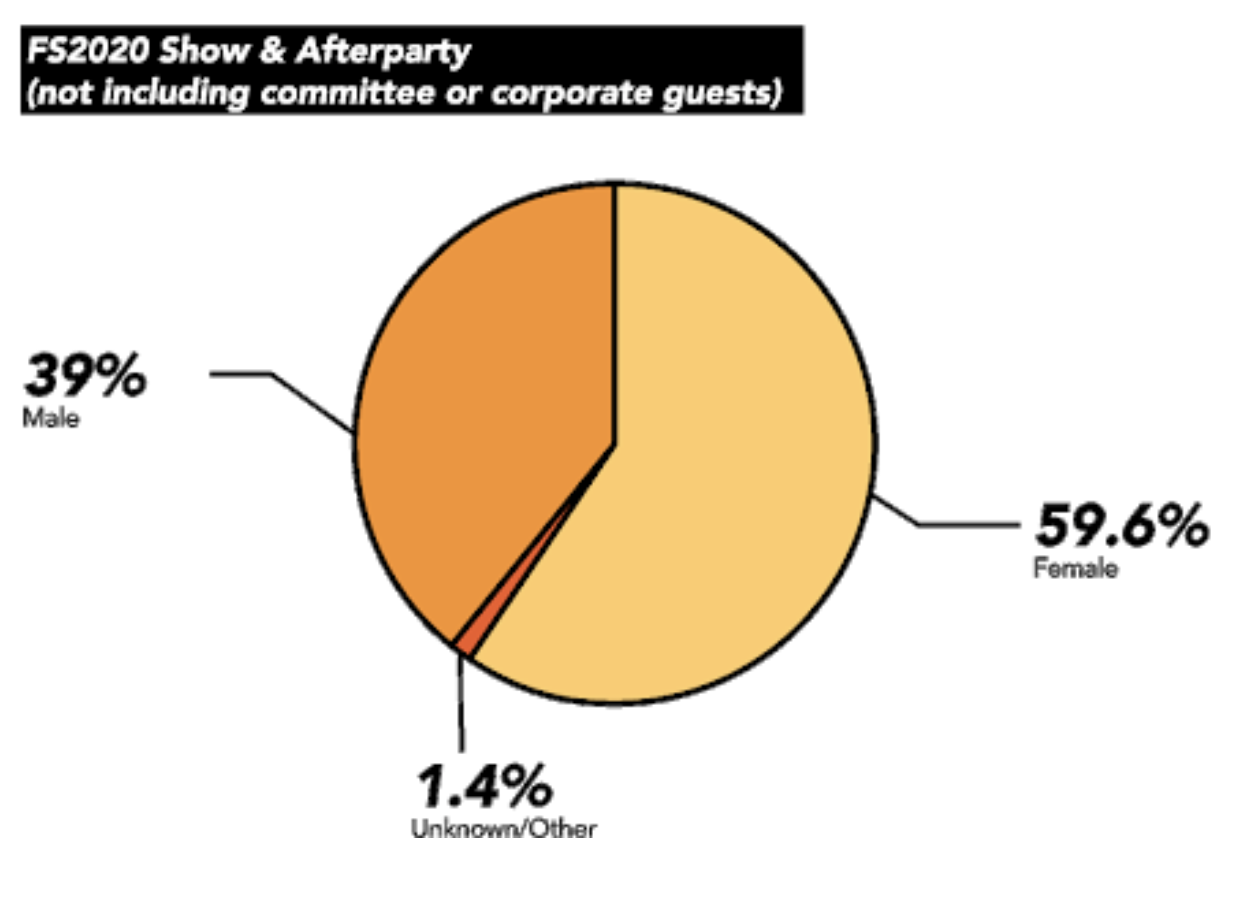FS Gender Diversity Report 2020-2021
By Cordelia Hare & Stella Coulter
Part of the FS mission is to highlight the role all students play in determining the future of the fashion industry. What this means is that we have to emulate the change and practices we want to see in the industry at large. Without taking stock of FS as it stands now, we have no way of knowing if we need to change, and if so, how to engender that change. Engaging students in deserving philanthropic causes is another part of our mission, but we can’t properly promote the welfare of others if we don’t first ensure the welfare of our guests, our committee, and our immediate community. Fostering diversity and inclusivity is an important part of that welfare, and we intend to create an environment that bolsters these values moving forward. These transparency reports are some of the steps we are taking to remain accountable to our community. Most importantly, transparency cannot exist for “transparency’s sake;” we must take action to ensure a more level playing field.
Because FS only appoints students that attend the University of St Andrews, we are comparing our organisation’s statistics with the University’s statistics and will do so throughout all of our transparency reports. FS has collected the University's breakdown of gender diversity from its Equality Mainstreaming Interim Report (2017 – 2021), published on the 30th of April, 2019. The report states that “[t]he proportion of female students at undergraduate level has gradually decreased over the three years from 60.1% in 2016-17 to 59.7% in 2018-19.”
As pictured, our FS2020 Show had a guest attendance that is in line with the population gender composition of the University with 59.6% of attendees self-identifying as female. Composition of attendance was similar in previous years with 59.0% of attendees at FS2019 being female and 63.5% of attendees being female at FS2018.
The attendees of Starfields have consisted of a greater proportion of female students to male students, with an average of 63.55% of attendees being female over the past three years. While this is higher in comparison to the gender split/divide of the undergraduate population that is female (59.7%), the difference in values is not statistically significant. Nevertheless, the appearance that a larger proportion of St Andrews female undergraduate body attends Starfields compared to male undergrad students may be due to a large range of factors, from music preferences to ticket purchasing habits to marketing. Moving forward, FS plans to stay conscious of all these decisions and more to ensure Starfields appeals to everyone evenly. We will be focusing more on bringing on freshers reps that better represent the community of students and continuing to choose artists that have wide appeal.
The fashion industry is unfortunately rife with gender inequality - only 14 percent of major fashion brands have a female executive, and less than 50% of household-name womenswear brands have head designers that are women. McKinsey & Company found that the four primary sources of gender inequality in the fashion industry were 1) a lack of awareness of and commitment to the issue at hand due to the fashion industry being made up primarily of women, even though they do not proportionally make up top-level jobs; 2) ambiguous and uneven understanding of success criteria; 3) disparities in sponsorship and mentorship leaving far fewer women to get the career advice they seek from ranking colleagues and finally; 4) the constraints of work/life balance, which were exacerbated by a lack of formal programs like flexible work hours, as well as the unconscious biases that affect women whose career motivations and ambitions may be questioned after having children.
It is evident that the fashion industry has failed to create equal opportunities and to promote diverse and equal representation. FS takes an active stance to ensure that we are not being complicit in these practices. To promote equal opportunity, FS publicly announces new positions and opens applications to all, guaranteeing experienced committee members and new alike the opportunity to take part in FS. This creates a clearer path to advancement within FS and develops people’s abilities to cultivate their ambitions.
We also recognize that while not female-led, the fashion industry is typically seen as female-centric. We believe that everyone should be able to discover and explore interests without consideration of its gendering. We make a conscious effort to encourage men to join our organization, as shown by the increase of male committee members from 24% for the 2020 rendition, to 31% for 2021.
Check back in October to see our Ethnicity Transparency report.
————————————————————————————————————————————





